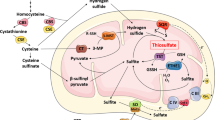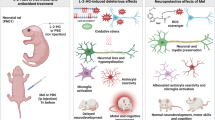Abstract
Patients with sulfite oxidase (SO) deficiency present severe brain abnormalities, whose pathophysiology is not yet elucidated. We evaluated the effects of sulfite and thiosulfate, metabolites accumulated in SO deficiency, on creatine kinase (CK) activity, mitochondrial respiration and redox status in hippocampus, striatum and cerebellum of developing rats. Our in vitro results showed that sulfite and thiosulfate decreased CK activity, whereas sulfite also increased malondialdehyde (MDA) levels in all brain structures evaluated. Sulfite further diminished mitochondrial respiration and increased DCFH oxidation and hydrogen peroxide production in hippocampus. Sulfite-induced CK activity decrease was prevented by melatonin (MEL), resveratrol (RSV), and dithiothreitol while increase of MDA levels was prevented by MEL and RSV. Regarding the antioxidant system, sulfite increased glutathione concentrations in hippocampus and striatum. In addition, sulfite decreased the activities of glutathione peroxidase in all brain structures, of glutathione S-transferase in hippocampus and cerebellum, and of glutathione reductase in cerebellum. In vivo experiments performed with intrahippocampal administration of sulfite demonstrated that this metabolite increased superoxide dismutase activity without altering other biochemical parameters in rat hippocampus. Our data suggest that impairment of energy metabolism and redox status may be important pathomechanisms involved in brain damage observed in individuals with SO deficiency.







Similar content being viewed by others
References
Aksenov MY, Markesbery WR (2001) Change in thiol content and expression of glutathione redox system gene in the hippocampus and cerebellum in Alzheimer’s disease. Neurosci Lett 302:141–145
Arstall MA, Bailey C, Gross WL, Bak M, Balligand JL, Kelly RA (1998) Reversible S-nitrosation of creatine kinase by nitric oxide in adult rat ventricular myocytes. J Mol Cell Cardiol 30:979–988
Baker MT, Dehring DJ, Gregerson MS (2002) Sulfite supported lipid peroxidation in propofol emulsions. Anesthesiology 97:1162–1167
Basheer SN, Waters PJ, Lam CW, Acquaviva-Bourdain C, Hendson G, Poskitt K, Hukin J (2007) Isolated sulfite oxidase deficiency in the newborn: lactic acidaemia and leukoencephalopathy. Neuropediatrics 38:38–41
Baur JA, Sinclair DA (2006) Therapeutic potential of resveratrol: the in vivo evidence. Nat Rev Drug Discov 5(6):493–506
Bellaver B, Bobermin LD, Souza DG, Rodrigues MD, de Assis AM, Wajner M, Gonçalves CA, Souza DO, Quincozes-Santos A (2016) Signaling mechanisms underlying the glioprotective effects of resveratrol against mitochondrial dysfunction. Biochim Biophys Acta 1862(9):1827–1838
Bindu PS, Christopher R, Mahadevan A, Bharath RD (2011) Clinical and imaging observations in isolated sulfite oxidase deficiency. J Child Neurol 26:1036–1040
Browne RW, Armstrong D (1998) Reduced glutathione and glutathione disulfide. Methods Mol Biol 108:347–352
Carlberg I, Mannervik B (1985) Glutathione reductase. Methods Enzymol 113:484–490
Chan KY, Li CK, Lai CK, Ng SF, Chan AY (2002) Infantile isolated sulphite oxidase deficiency in a Chinese family: a rare neurodegenerative disorder. Hong Kong Med J 8:279–282
Chiarani F, Bavaresco CS, Dutra-Filho CS, Netto CA, Wyse AT (2008) Sulfite increases lipoperoxidation and decreases the activity of catalase in brain of rats. Metab Brain Dis 23:123–132
da Silva CG, Bueno AR, Schuck PF, Leipnitz G, Ribeiro CA, Rosa RB, Dutra Filho CS, Wyse AT, Wannmacher CM, Wajner M (2004) Inhibition of creatine kinase activity from rat cerebral cortex by D-2-hydroxyglutaric acid in vitro. Neurochem Int 44(1):45–52
de Oliveira MR, Nabavi SF, Manayi A, Daglia M, Hajheydari Z, Nabavi SM (2016) Resveratrol and the mitochondria: from triggering the intrinsic apoptotic pathway to inducing mitochondrial biogenesis, a mechanistic view. Biochim Biophys Acta 1860(4):727–745
Derin N, Yargiçoğlu P, Aslan M, Elmas O, Agar A, Aicigüzel Y (2006) The effect of sulfite and chronic restraint stress on brain lipid peroxidation and anti-oxidant enzyme activities. Toxicol Ind Health 22:233–240
Derin N, Akpinar D, Yargicoglu P, Agar A, Aslan M (2009) Effect of alpha-lipoic acid on visual evoked potentials in rats exposed to sulfite. Neurotoxicol Teratol 31:34–39
Du F, Cooper A, Lukas SE, Cohen BM, Ongur D (2013) Creatine kinase and ATP synthase reaction rates in human frontal lobe measured by (31)P magnetization transfer spectroscopy at 4T. Magn Reson Imaging 31:102–108
Dublin AB, Hald JK, Wootton-Gorges SL (2002) Isolated sulfite oxidase deficiency: MR imaging features. AJNR Am J Neuroradiol 23(3):484–485
Edwards MC, Johnson JL, Marriage B, Graf TN, Coyne KE, Rajagopalan KV, MacDonald IM (1999) Isolated sulfite oxidase deficiency: review of two cases in one family. Ophthalmology 106:1957–1961
Esterbauer H, Cheeseman KH (1990) Determination of aldehydic lipid peroxidation products: malonaldehyde and 4-hydroxynonenal. Methods Enzymol 186:407–421
Galano A (2011) On the direct scavenging activity of melatonin towards hydroxyl and a series of peroxyl radicals. Phys Chem 13:7178–7188
Grings M, Moura AP, Parmeggiani B, Marcowich GF, Amaral AU, de Souza Wyse AT, Wajner M, Leipnitz G (2013) Disturbance of brain energy and redox homeostasis provoked by sulfite and thiosulfate: potential pathomechanisms involved in the neuropathology of sulfite oxidase deficiency. Gene 531(2):191–198
Grings M, Moura AP, Amaral AU, Parmeggiani B, Gasparotto J, Moreira JC, Gelain DP, Wyse AT, Wajner M, Leipnitz G (2014) Sulfite disrupts brain mitochondrial energy homeostasis and induces mitochondrial permeability transition pore opening via thiol group modification. Biochim Biophys Acta 1842(9):1413–1422
Grings M, Moura AP, Parmeggiani B, Motta MM, Boldrini RM, August PM, Matté C, Wyse AT, Wajner M, Leipnitz G (2016) Higher susceptibility of cerebral cortex and striatum to sulfite neurotoxicity in sulfite oxidase-deficient rats. Biochim Biophys Acta 1862(11):2063–2074
Gunnison AF, Sellakumar A, Currie D, Snyder EA (1987) Distribution, metabolism and toxicity of inhaled sulfur dioxide and endogenously generated sulfite in the respiratory tract of normal and sulfite oxidase-deficient rats. J Toxicol Environ Health 21(1–2):141–162
Halliwell B, Gutteridge JMC (2007) Measurement of reactive species, 4th edn. Oxford University Press, Oxford, pp 268–337
Herken EN, Kocamaz E, Erel O, Celik H, Kucukatay V (2009) Effect of sulfite treatment on total antioxidant capacity, total oxidant status, lipid hydroperoxide, and total free sulfydryl groups contents in normal and sulfite oxidase-deficient rat plasma. Cell Biol Toxicol 25:355–362
Hughes BP (1962) A method for estimation of serum creatine kinase and its use in comparing creatine kinase and aldolase activity in normal and pathological sera. Clin Chim Acta 7:597–603
Johnson JL, Duran M (2001) Molybdenum cofactor deficiency and isolated sulfite oxidase deficiency. In: Scriver CR, Valle D, Sly WS (eds) The metabolic and molecular bases of inherited disease. McGraw-Hill, New York, pp 3181–3217
Konorev EA, Hogg N, Kalyanaraman B (1998) Rapid and irreversible inhibition of creatine kinase by peroxynitrite. FEBS Lett 427:171–174
Küçükatay V, Savcioğlu F, Hacioğlu G, Yargiçoğlu P, Ağar A (2005) Effect of sulfite on cognitive function in normal and sulfite oxidase deficient rats. Neurotoxicol Teratol 27:47–54
LeBel CP, Ischiropoulos H, Bondy SC (1992) Evaluation of the probe 2′,7′-dichlorofluorescin as an indicator of reactive oxygen species formation and oxidative stress. Chem Res Toxicol 5(2):227–231
Li C, Sun S, Park D, Jeong HO, Chung HY, Liu XX, Zhou HM (2011) Hydrogen peroxide targets the cysteine at the active site and irreversibly inactivates creatine kinase. Int J Biol Macromol 49:910–916
Lowry OH, Rosebrough NJ, Farr AL, Randall RJ (1951) Protein measurement with the Folin phenol reagent. J Biol Chem 193:265–275
Makrecka-Kuka M, Krumschnabel G, Gnaiger E (2015) High-resolution Respirometry for simultaneous measurement of oxygen and hydrogen peroxide fluxes in Permeabilized cells, tissue homogenate and isolated mitochondria. Biomol Ther 5(3):1319–1338
Mannervik B, Guthenberg C (1981) Glutathione transferase (human placenta). Methods Enzymol 77:231–235
Marklund SL (1985) Product of extracellular-superoxide dismutase catalysis. FEBS Lett 184(2):237–239
Miller E, Morel A, Saso L, Saluk J (2015) Melatonin redox activity. Its potential clinical applications in neurodegenerative disorders. Curr Top Med Chem 15(2):163–169
Mottley C, Mason RP (1988) Sulfate anion free radical formation by the peroxidation of (bi)sulfite and its reaction with hydroxyl radical scavengers. Arch Biochem Biophys 267:681–689
Ngu LH, Afroze B, Chen BC, Affandi O, Zabedah MY (2009) Molybdenum cofactor deficiency in a Malaysian child. Singap Med J 50:365–367
Niknahad H, O’Brien PJ (2008) Mechanism of sulfite cytotoxicity in isolated rat hepatocytes. Chem Biol Interact 174(3):147–154
Ozturk OH, Oktar S, Aydin M, Kucukatay V (2010) Effect of sulfite on antioxidant enzymes and lipid peroxidation in normal and sulfite oxidase-deficient rat erythrocytes. J Physiol Biochem 66:205–212
Parmeggiani B, Moura AP, Grings M, Bumbel AP, de Moura AL, Tauana Pletsch J, Fernandes CG, Wyse AT, Wajner M, Leipnitz G (2015) In vitro evidence that sulfite impairs glutamatergic neurotransmission and inhibits glutathione metabolism-related enzymes in rat cerebral cortex. Int J Dev Neurosci 42:68–75
Paxinos G, Watson C (1986) The rat brain in stereotaxic coordinates, 2nd edn. Academic Press, San Diego
Ramis MR, Esteban S, Miralles A, Tan DX, Reiter RJ (2015) Caloric restriction, resveratrol and melatonin: role of SIRT1 and implications for aging and related-diseases. Mech Ageing Dev 146-148:28–41
Reiter RJ, Tan DX, Manchester LC, Qi W (2001) Biochemical reactivity of melatonin with reactive oxygen and nitrogen species: a review of the evidence. Cell Biochem Biophys 34:237–256
Robinson HC, Pasternak CA (1964) The isolation of S-sulphoglutathione from the small intestine of the rat. Biochem J 93(3):487–492
Schwarz G, Mendel RR, Ribbe MW (2009) Molybdenum cofactors, enzymes and pathways. Nature 460(7257):839–847
Springer JE, Azbill RD, Carlson SL (1998) A rapid and sensitive assay for measuring mitochondrial metabolic activity in isolated neural tissue. Brain Res Protocol 2:259–263
Stachowiak O, Dolder M, Wallimann T, Richter C (1998) Mitochondrial creatine kinase is a prime target of peroxynitrite-induced modification and inactivation. J Biol Chem 273:16694–16699
Tamura H, Takasaki A, Taketani T, Tanabe M, Kizuka F, Lee L, Tamura I, Maekawa R, Asada H, Yamagata Y, Sugino N (2013) Melatonin as a free radical scavenger in the ovarian follicle. Endocr J 60:1–13
Tan WH, Eichler FS, Hoda S, Lee MS, Baris H, Hanley CA, Grant PE, Krishnamoorthy KS, Shih VE (2005) Isolated sulfite oxidase deficiency: a case report with a novel mutation and review of the literature. Pediatrics 116:757–766
Taylor SL, Higley NA, Bush RK (1986) Sulfites in foods: uses, analytical methods, residues, fate, exposure assessment, metabolism, toxicity, and hypersensitivity. Adv Food Res 30:1–76
Vandevijvere S, De Vriese S, Huybrechts I, Moreau M, Van Oyen H (2010) Overall and within-food group diversity are associated with dietary quality in Belgium. Public Health Nutr 13(12):1965–1973
Vincent AS, Lim BG, Tan J, Whiteman M, Cheung NS, Halliwell B, Wong KP (2004) Sulfite-mediated oxidative stress in kidney cells. Kidney Int 65:393–402
Wallimann T, Dolder M, Schlattner U, Eder M, Hornemann T, Kraft T, Stolz M (1998) Creatine kinase: an enzyme with a central role in cellular energy metabolism. MAGMA 6:116–119
Wang PF, McLeish MJ, Kneen MM, Lee G, Kenyon GL (2001) An unusually low pK(a) for Cys282 in the active site of human muscle creatine kinase. Biochemistry-US 40:11698–11705
Wendel A (1981) Glutathione peroxidase. Methods Enzymol 77:325–332
Wendt S, Schlattner U, Wallimann T (2003) Differential effects of peroxynitrite on human mitochondrial creatine kinase isoenzymes. Inactivation, octamer destabilization, and identification of involved residues. J Biol Chem 278:1125–1130
Zhang X, Vincent AS, Halliwell B, Wong KP (2004) A mechanism of sulfite neurotoxicity: direct inhibition of glutamate dehydrogenase. J Biol Chem 279:43035–43045
Zaki MS, Selim L, El-Bassyouni HT, Issa MY, Mahmoud I, Ismail S, Girgis M, Sadek AA, Gleeson JG, Abdel Hamid MS (2016) Molybdenum cofactor and isolated sulphite oxidase deficiencies: clinical and molecular spectrum among Egyptian patients. Eur J Paediatr Neurol 20(5):714–722
Acknowledgements
This work was supported by grants from Conselho Nacional de Desenvolvimento Científico e Tecnológico (CNPq), Programa de Apoio a Núcleos de Excelência (PRONEX II), Fundação de Amparo à Pesquisa do Estado do Rio Grande do Sul (FAPERGS), Pró-Reitoria de Pesquisa/Universidade Federal do Rio Grande do Sul (PROPESQ/UFRGS), Financiadora de estudos e projetos (FINEP), Rede Instituto Brasileiro de Neurociência (IBN-Net) # 01.06.0842-00 and Instituto Nacional de Ciência e Tecnologia em Excitotoxicidade e Neuroproteção (INCT-EN).
Author information
Authors and Affiliations
Corresponding author
Ethics declarations
Ethical Approval
The experimental protocol was approved by the Ethics Committee for Animal Research of the UFRGS, Porto Alegre, Brazil, and followed the “National Institutes of Health Guide for the Care and Use of Laboratory Animals” (NIH Publications No. 80–23, revised 1978)
Conflict of Interest
The authors declare that they have no conflict of interest.
Rights and permissions
About this article
Cite this article
de Moura Alvorcem, L., da Rosa, M.S., Glänzel, N.M. et al. Disruption of Energy Transfer and Redox Status by Sulfite in Hippocampus, Striatum, and Cerebellum of Developing Rats. Neurotox Res 32, 264–275 (2017). https://doi.org/10.1007/s12640-017-9732-y
Received:
Revised:
Accepted:
Published:
Issue Date:
DOI: https://doi.org/10.1007/s12640-017-9732-y




